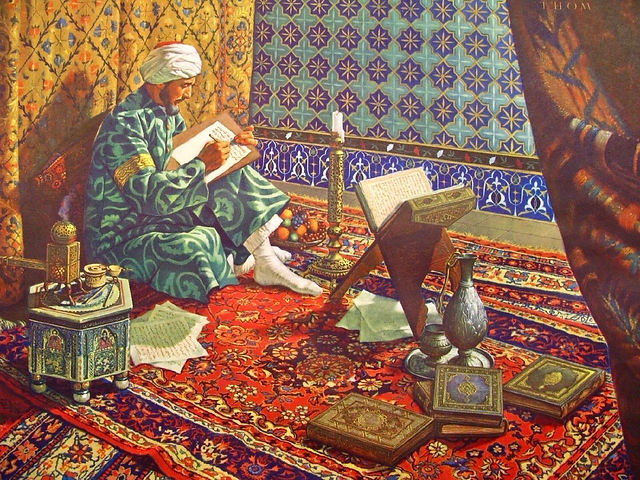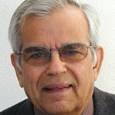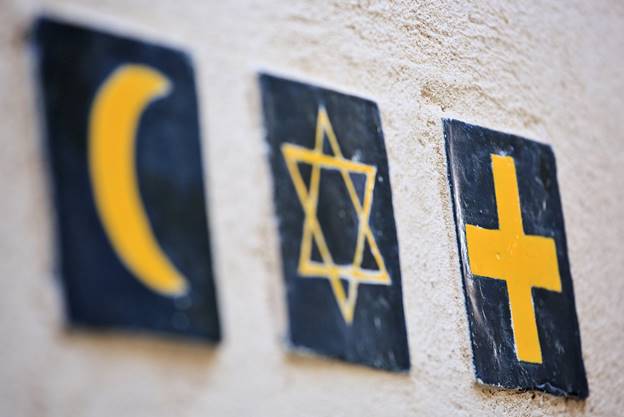

Rationalism from early Islam sparked the Latin-European exit from its Dark Ages and contributed to the making of the modern West. Given the ‘dark-age’ state of the contemporary Islamic world, one wonders if the rationalism of early Islam can come full circle. Can there be a renewal of Ijtihaad that can launch another “Islamic Awakening,” more dynamic than that of the Golden Age? Can the Islamic world move forward to the 2lst century — modernizing, yet not necessarily “Westernizing,” without losing the essence of its pristine Islam? That is the challenge for Muslim intellectuals. And there also lies the great potential. – Image credit Bayt Al Fann
Civilizational Connections: Islam and the West
By Dr S.M. Ghazanfar
Emeritus-Faculty (Economics)
University of Idaho
Moscow, Idaho

In a 1999 speech, the former UN Secretary-General, Kofi Annan, called for a "Dialogue among Civilizations," as a counter to the "Clash of civilizations" theme propounded by Harvard University's Samuel Huntington in 1993. Instead of the “clash,” he pointed to the “strong stamp” of historical Islam that enabled Western transformation out of the Dark Ages. Indeed, till about the close of the seventeenth century, learning from the Islamic world contributed to the florescence of knowledge in the West, with science and other disciplines taught mainly from Muslim scholars’ translated works. The mainstream literary paradigm, however, presents the evolution of Western Civilization as one straight line of events, almost entirely beginning and ending with the West.
The most significant ‘paradigm lost’ in this historiography pertains to the Islam-West connections — what some scholars call “colossal misrepresentation” and “worse than a lie.” To be sure, however, in recent years, notwithstanding the current divisive religious and cultural environment, there is some gingerly recognition among some scholars (even in the US Congress) that, indeed, ours is a Judeo-Christian- and-Islamic Civilization.
As background to these connections, it is important to note that the Greek heritage, viewed as a threat to early Christianity, was “closed shut” by the Roman Emperor Justinian in 529AD until its eighth-century “rediscovery” by the Abbasid Islam via the Byzantines. And then Caliph Haroon Al-Mamoon established a pluralistic “think-tank” in 813 AD, in Baghdad, called the Bayt al-Hikma (House of Wisdom), made up of scholars from various faiths and disciplines.
The supreme mission of this institution was to search and develop knowledge; after all, Prophet Mohammed had insisted that the search of knowledge be a duty for all Muslims. A major aspect of that mission was to translate, assimilate, adapt, and further build upon the Greek heritage; and this endeavor took place till about 1050AD.
While the Greek legacy was central, the assimilation process also included knowledge from other civilizations — Indian, Persian, and even Chinese. Thusly developed, the reservoir of knowledge later traveled to other parts of the Islamic world, including Islamic Spain (711-1492).
Following the “first age of translations” (from Greek to Arabic), the “second age of translations,” from Arabic to Latin, covered the period from early 900AD to 1300AD, which led to the transmission of that reservoir, via various sources and places, to Latin-Europe. The result was what some scholars call the “turning point” for the Latin-European transformation, from the Age of Ignorance to the Age of Reason and Rationality. Thus was provided, as one scholar argues, the stimulus for “Renaissance, the Protestant Reformation in the sixteenth century, and eventually the scientific revolution of the seventeenth century” (Harold Nebelsick, The Renaissance, the Reformation, and the Rise of Science, Edinburgh, 1992; p.9). And these connections, indeed, “make the cherished ancestry of our literary history, covering all areas of knowledge, a rather mixed ancestry” (S.M. Ghazanfar, Medieval Islamic Economic Thought: Filling the ‘Great Gap’ in European Economics, London, 2003; p.205).
What was the nature and impact of these connections? As one scholar puts it, “Under the impact of this encounter, the West took the step toward cultivation of specialized sciences, out of the original philosophical core. Every single specialized science in the West owes its origin to the Islamic impulse, or at least its direction from that time on. It was from Islam that the Middle Ages learned to look on nature as an infinitely varied reality, not as a philosophical idea …. the effect was an intellectual stimulation without parallel. Virtually every aspect of European life from religion to philosophy to governmental institutions to architecture, personal mores, and romantic poetry, was profoundly affected” (Thomas Goldstein, The Dawn of Modern Science, Boston, 1988; p.99). Further, another scholar argues that knowledge from the Islamic world generated “that confidence in the power of reason and that faith in the rationality of the universe without which science would have been impossible” (Christopher Dawson, The Formation of Christianity, Boston, 1967; p.230). Yet another eminent historian of science (knowledge) discusses the “Greek miracle” and “the miracle of Arab science,” and, while discussing the role of Islam in the formation of Western culture, he notes as “one of the most fruitful events in the history of mankind: the birth of Islam” (George Sarton, The Incubation of Western Culture in the Middle East, Washington, DC, 1951; p.15).

To be sure, in recent years, notwithstanding the current divisive religious and cultural environment, there is some gingerly recognition among some scholars (even in the US Congress) that, indeed, ours is a Judeo-Christian- and -Islamic Civilization – Image credit Boston University
Thus, in contrast to the literature-arts 16th Italian renaissance, more importantly, the “vision of a profoundly secular renaissance” that emphasized philosophy and science, evolved through links with the early Islamic Civilization (Robert Benson and Giles Constable, Renaissance and Renewal in the Twelfth Century, Cambridge, MA., 1977; p.xxiii; also see Charles Homer Haskins, The Renaissance of the Twelfth-Century, Cambridge, MA., 1927). It had “no roots in the earlier medieval culture of the West. It is neither Christian, nor Latin, nor Germanic … the origin of the new style are to be found in the rich and brilliant society of Muslim Spain” (Christopher Dawson, The Making of Europe, New York, 1952; p.153). Inspiration for this vision emanated from the writings of Muslim scholars; and there were numerous (‘latinized’ names in parenthesis): Al-Kindi (Alkindus), d.873; Al-Farabi (Alfarabus), d.950; Al-Khwarizmi (Algoritini or Algourizin), d.976; Ibn-Sina (Avicenna), d.1036; Ibn-Haitham (Alhazen), d.1039; Al-Biruni (Alberonius), d.1048; Al-Ghazali (Algazal (d.1111; Ibn-Tufail(Abentofail), d.1186; Ibn-Rushd (Averroes), d.1198; Ibn-al-Arabi, d.1240; Ibn-Khaldun, d.1406; and others. Scholars invariably recognize Ibn Rushd’s role in this “rational revolution” in Latin-Europe as the most critical. We can briefly note the contribution and influence of a few:
(1) Abu Yusuf Al-Kindi (801-873): known as the “philosopher of the Arabs,” his work on geometrical and physiological optics was a key influence upon Roger Bacon (1214-1292) and others
(2) Abu Bakr Al-Razi (863-925): known as the “Arabic Galen,” wrote volumes on medicine and philosophy, and his works were translated into Latin and reprinted several times
(3) Abu-Nasr Al-Farabi (870-950): wrote on numerous topics, but is best known for his The Encyclopedia , an account of various branches of science and art known then, and The Political Regime , also known as The Book of Principles; profoundly influenced Albertus Magnus and his student, St Thomas Aquinas (who almost word-for-word quoted Al-Farabi)
(4) Abu Ali Ibn Sina (980-1037): his writings constituted a Latin School of Avicenna and formed a bridge between the Greeks and Renaissance Europe; his The Cannon of Medicine remained the standard text until seventeenth-century; influenced numerous Jewish and Christian scholastics
(5) Abu Hamid Al-Ghazali (1058-1111): exerted great influence on Jewish (e.g., Moses Maimonides, 1134-1204) and Christian scholastics --Raymund Martin (d.1284), Raymund Lull (1232-1315). Albertus Magnus (d. 1280) and his student, St. Thomas Aquinas (1225-1274) in particular; Ghazali’s “faith-vs-reason” synthesis, Ihya Ulum al-Din (Revival of the Religious Sciences) paralleled St. Thomas’ Summa Theologica
(6) Abu Walid Ibn Rushd (1126-1198), The Great Commentator: his writings also led to a Latin School of Avveroes; the most influential Muslim scholar in the Latin-West, the ultimate rationalist, “the landmark of reason,” the Aristotelian heretic of early Islam and Christianity; his writings created an intellectual revolution in Latin-Europe. Will Durant suggests that “Thomas Aquinas was led to write his Summas to halt the threatened liquidation of Christian theology by Arabic interpretations of Aristotle; indeed, the industry of Aquinas was due not to the love of Aristotle but to the fear of Averroes” (Will Durant, The Story of Civilization, Vol.IV, New York, 1950; p.954).
Aside from some Latin-European scholars identified above, there were others similarly influenced: Roger Grossetteste, Duns Scottus, Domingo Gundisalvo, Siger of Brabant, Nicholas Oresme, Gebert of Aurillac (later Pope Sylvester II, 999-1003AD), Adelard of Bath, Peter Abelard, John Peckman, Henry of Gant, William of Occam, Dante Aligheri, Rene Descartes, Nicholas Copernicus, Johannes Kepler, Galileo Galilei, Blaise Pascal, and others.
What were some major sources for this ‘miracle of transmission’? There were several — travels, translations, oral tradition, trade and commerce, cultural diffusion, the Crusades, and other miscellaneous factors; and these may be briefly noted:
1. Travels to Islamic lands during the eleventh and twelfth centuries by Latin scholars (many knew Arabic) who brought back knowledge to Europe; in addition, upon return, they also established universities, patterned after Muslim institutions, e.g., Naples, Salamanca, Oxford, Montepeller, Paris, and others.
2. Translations en mass during the 9th through 13th centuries and beyond --Arabic scholarship into Latin, the "second age of translations;" and this took place in Spain, Italy, Sicily, and France -- Toledo being about the most prominent; “the intellectual plunder of Toledo brought the scholars of northern Europe like moths to a candle” (James Burke, The Day the Universe Changed, Boston, 1985, p.40.
3. Oral transmission , facilitated by over eight or more centuries of intimate interaction between Muslims and Christians in Spain where bilingualism was common; and this provided a “cultural environment in which people of different religions and ethnic backgrounds lived together for centuries … conducive to intellectual interaction and borrowing. It was a melting pot and a laboratory” (Anwar Chejne in Islam and the West: Aspects of Intercultural Relations, Albany, NY, 1980; p.113).

Image credit QuoteFancy
4. Trade and commerce , leading to the diffusion of business practices, which were at variance with the rigid pattern of medieval Europe’s socio-economic organization; further, in addition to the frequency of Arab coins in Europe, numerous techniques and methods of commerce, as well as the spirit of enterprise, spread to Europe (M.A. Cook in The Legacy of Islam, Oxford, England, 1974; p.219).
5. Diffusion of institutions and practices , as commercial links evolved; contractual business arrangements ( commenda in Arabic) spread to Latin-Europe, as well as other instruments and institutions, such as the bill of exchange ( siftajah ), letter of credit ( hawala ), specialized trading centers ( funduq ), etc.
6. The Crusades -- their central role is how “they helped to shape European attitudes, feelings, and values,” and “stimulated the intellectual life of Europe” (Stephen Ferrueolo in Renaissance Before the Renaissance: Cultural Revival of Late Antiquity and the Middle Ages, Stanford, Calif.; p.136); further, they represented the “strongest influence in developing the medieval trade and industry” (H.C. Krueger in Twelfth Century Europe and the Foundations of Modern Society, Madison, WI., 1961, p.72).
In addition, there were other miscellaneous sources — students traveling to Islamic lands and bringing back admiration for Arab literature; monasteries and cathedral schools where students were exposed to Arab science and philosophy; royal courts where often Arab knowledge was disseminated; missionaries who traveled abroad and brought back knowledge; and various European cities and towns, many of which originated in the “footsteps of trade” with the Mediterranean Islamic world.
For the essential theme of this narrative, the following quote is appropriate: “Because Europe was reacting against Islam, it belittled the influence of Saracens (Muslims) and exaggerated its dependence on its Greek and Roman heritage. So today an important task for us is to correct this false emphasis and to acknowledge fully our debt to the Arab and Islamic world” (W. Montgomery Watt, Islamic Surveys: The Influence of Islam on Medieval Europe, Edinburgh, England, 1972; p.84).
Additionally, in conclusion, one can point to the transformational challenges for the Islamic world. Rationalism from early Islam sparked the Latin-European exit from its Dark Ages and contributed to the making of the modern West. Given the ‘dark-age’ state of the contemporary Islamic world, one wonders if the rationalism of early Islam can come full circle. Can there be a renewal of Ijtihaad that can launch another “Islamic Awakening,” more dynamic than that of the Golden Age? Can the Islamic world move forward to the 2lst century — modernizing, yet not necessarily “Westernizing,” without losing the essence of its pristine Islam? That is the challenge for Muslim intellectuals. And there also lies the great potential.
(Dr Ghazanfar is a widely-published scholar, especially in the area of contributions of Islamic Civilization (particularly socio-economic thought) and influence on Western transformation.)
Further readings:
1. S.M. Ghazanfar, Islamic Civilization--History, Contributions, and Influence: A Compendium of Literature; Scarecrow Press (Rowman-Littlefield Publishers), Lanham, Maryland 2006
2. Mark A. Graham, How Islam Created the Modern World; Amana Publishers, New York; 2006
3. David L. Lewis, God’s Crucible: Islam and the Making of Europe, 570-1215; W.W. Norton, New York; 2007
4. Jonathan Lyon, The House of Wisdom: How the Arabs Transformed Western Civilization; Bloomsbury Press, New York; 2010
5. Michael H. Morgan, Lost World: The Enduring Legacy of Muslim Scientists, Thinkers, and Artists, National Geographic Society, Washington, D.C.; 2007
6. Nayef Al-Rodhan (Editor), The Role of the Arab-Islamic World in the Rise of the West: Implications for Trans-Cultural Relations; Palgrave-Macmillan, New York; 2012
7. Tim Wallace-Murphy, What Islam did for us: Understanding Islam's Contributions to Western Civilization; Watkins Publishing, London; 2006
8. Frederick Quinn, The Sum of All Heresies: The Image of Islam in Western Thought; Oxford University Press, New York; 2008
9. George Saliba, Islamic Science and the Making of the European Renaissance; The MIT Press, Cambridge, MA.; 2011

